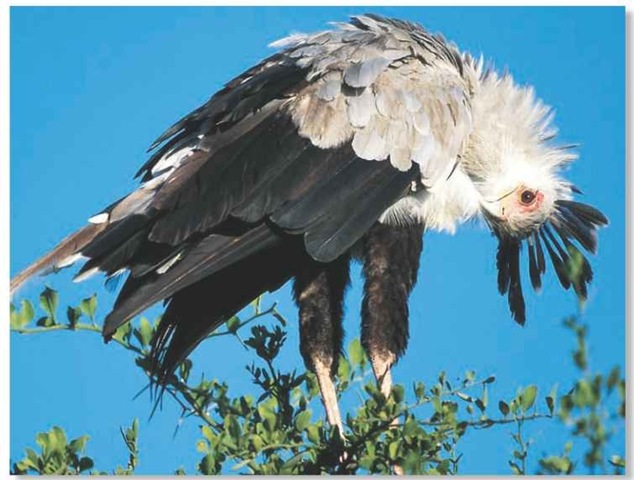ORDER
Falconiformes
FAMILY
Sagittaridae
GENUS & SPECIES
KEY FEATURES
• The only bird of prey that hunts on foot, stalking through the long grass of the African savannah
• Uses its spindly, storklike legs for stamping on victims too big to be seized in the bill
• Adorned with an untidy, but distinctive crest of head feathers, which it raises when excited
WHERE IN THE WORLD!
Found on open savannah and plains over much of sub-Saharan Africa, southward to the Cape of South Africa; absent only from forested and mountainous areas of western central Africa

Lifecycle
Renowned as the snake catcher of the African savannah, the secretary bird actually feeds on a wider range of prey and hunts as it walks along rather than from the air.
Habitat
Savannah grasslands and plains south of the Sahara are the secretary bird’s habitat. It avoids densely vegetated areas, forests and rocky, broken country, preferring open areas with sparse cover where it can easily forage for prey. However, it requires some tree cover to nest and roost in safety.
The density of birds in any one area depends on food availability; populations vary widely in different parts of Africa. In the grasslands of the far south, for example, there may be just a single pair ranging over 20 sq. miles, while on the tropical savannah one pair per 8 sq. miles is more common.
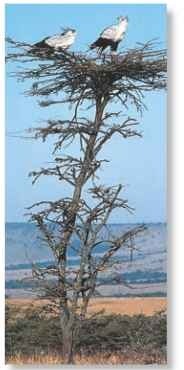
A Family tree The secretary bird is usually seen in pairs at its roost or nest site, but several birds may congregate to drink at a waterhole (left).
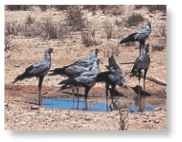
The secretary bird is considered so beneficial that farmers in southern Africa keep domesticated birds to control snakes and rats.
With frequent food shortages in the secretary bird’s habitat, it’s common for only one chick from each brood to reach adulthood.
Food & hunting
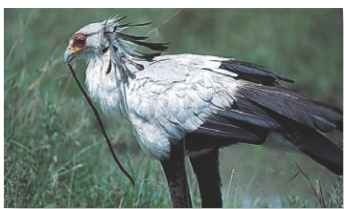
Any small animal up to the size of a young hare may fall prey to the secretary bird, but its staple food tends to be small ground mammals and large insects. It also eats young birds and reptiles, and is noted for catching snakes. It hunts prey on foot by strolling along, then suddenly speeding up and stamping its feet. This is thought to panic a hidden creature into making a sudden move, thereby revealing its presence to the hungry bird.
When prey is spotted, the bird dashes forward with wings outstretched. Most prey is taken in the bill, but it also stamps on larger prey to kill it, using its wings for balance. If the bird has trouble subduing larger prey, it may launch into the air with the victim, then drop it from the sky to stun or kill it.
The bird doesn’t usually eat carrion, but groups have been known to gather near the fringes of forest fires. Here they feast on the roasted bodies of small animals caught in the blaze.
Behavior
The secretary bird spends most of its time on the ground. It may walk more than 18 miles a day in search of food, pausing during the hottest periods in the shade of a tree. As its stalks the ground, it walks at about 3 mph — roughly the same pace as a human.
To advertise its territory, the bird takes to the sky almost every day. If one bird walks into the territory of another, serious battles break out. When a bird spots an intruder, it rushes up to it and tries to leap over it, striking down with its legs. The defender is usually victorious and returns to its mate. The birds then reinforce their bond with a display involving walking in circles with crests raised.
Courtship displays also consist of “circle-walking” and one or both birds soaring above their territory.
snake in the grass

Stamping ground…
With a steady gait and darting head movement similar to a chicken’s, the secretary bird watches for prey.
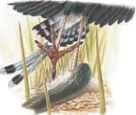
Target found…
Locating a snake in the grass, the bird pins it down with its broad feet.
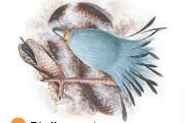
Bird’s eye view…
Flapping its wings to steady itself, the bird then strikes, killing its victim with its sharp, hooked bill.
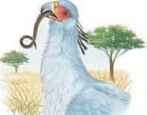
Slipping down
If the prey is small enough, the secretary bird eats it whole, usually swallowing it head first.
Ground work Much of the day is spent on the lookout for food.
Breeding
Unusual among raptors (birds of prey), the female secretary bird is slightly smaller than the male. Adult birds seem to pair for life and use the same nest year to year The nest is usually built 17-20′ from the ground, often on top of a thorny tree, such as an acacia. Over the years, nests may grow to a mass of sticks over 7′ across as more and more material is added. Unlike other raptors, the secretary bird doesn’t carry sticks for the nest in its feet; instead it carries them in its bill. The central cup of the nest is lined with dry grass.
Two or three small, pointed white eggs are laid at two-or three-day intervals. About 45 days later, the young hatch separated by a similar interval.
► Lone chick A chick stays in the nest until it’s fully fledged at 65-80 days.
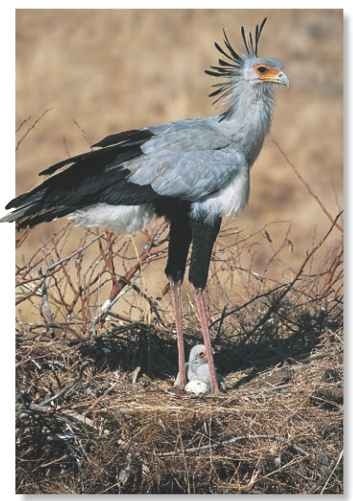

conservation
The secretary bird is in no danger, but is threatened in the north of its range where overgrazing by livestock and tree-logging for firewood reduced the landscape to near-desert conditions. Humans don’t persecute the bird because of its reputation as a killer of snakes; it’s protected over most of its range.
PROFILE
Secretary Bird
The secretary bird’s long, scaly legs provide protection against venomous reptiles as it strides over Africa’s grasslands in search of prey.

Creature comparisons
Another large, long-legged bird of the African tropical savannah is the marabou stork. Growing to 5′ tall, the adult stork is taller than the secretary bird.The stork’s neck is bare because the bird feeds on carrion, and feathers would get soiled. The bill can crack small bones, and the stork may wield it against ^eCbirdar^ vultures to force its way to the front of the line at gatherings around a carcass.The stork’s diet also includes rodents, reptiles and insects, including locusts. Both the secretary bird and the stork are generally silent, but during courtship displays they make deep, croaking grunts.

| VITAL STATISTICS Weight Up to 9 lbs.; males are heavier than females |
|
| Length | 4-5′ |
| Wingspan | 4′ |
| Sexual Maturity | 2 years |
| Breeding ” Season | All year (mainly spring and summer) |
| Number of Eggs | 2 or 3 |
| Incubation Period | 43-46 days |
| Fledging ; Period | About 80 days |
| Breeding Interval | 1 year |
| Typical Diet | Rodents, large insects, reptiles |
| Lifespan | ,0-,2 years |
RELATED SPECIES
• The secretary bird is : the only member of the family Sagittaridae; the name derives from the Latin word Sagittarius, meaning archer, and refers to the way the bird, like an archer, stalks its prey on foot. This is the feature that distinguishes it from the other 279 species of the order IFalconiformes, such as hawks and eagles, that hunt on the wing or swoop down from a perch.
